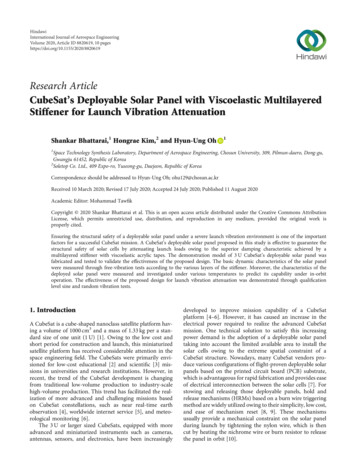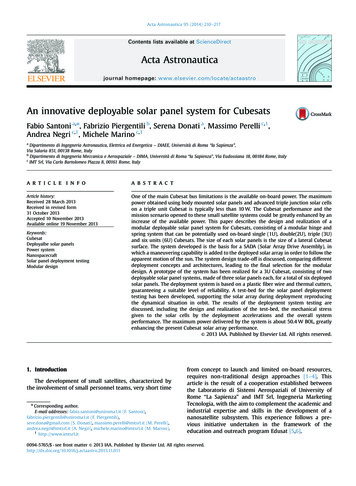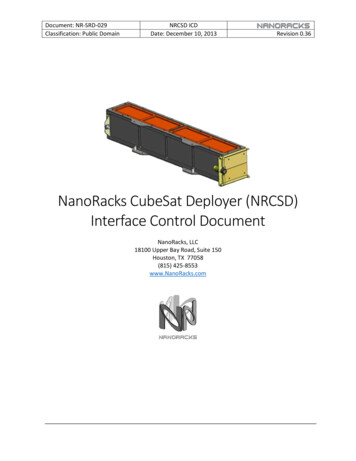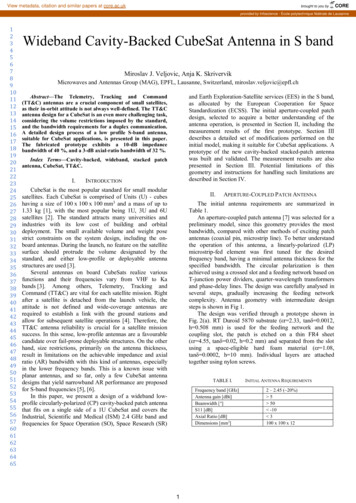
Transcription
HindawiInternational Journal of Aerospace EngineeringVolume 2020, Article ID 8820619, 10 pageshttps://doi.org/10.1155/2020/8820619Research ArticleCubeSat’s Deployable Solar Panel with Viscoelastic MultilayeredStiffener for Launch Vibration AttenuationShankar Bhattarai,1 Hongrae Kim,2 and Hyun-Ung Oh11Space Technology Synthesis Laboratory, Department of Aerospace Engineering, Chosun University, 309, Pilmun-daero, Dong-gu,Gwangju 61452, Republic of Korea2Soletop Co. Ltd., 409 Expo-ro, Yuseong-gu, Daejeon, Republic of KoreaCorrespondence should be addressed to Hyun-Ung Oh; ohu129@chosun.ac.krReceived 10 March 2020; Revised 17 July 2020; Accepted 24 July 2020; Published 11 August 2020Academic Editor: Mohammad TawfikCopyright 2020 Shankar Bhattarai et al. This is an open access article distributed under the Creative Commons AttributionLicense, which permits unrestricted use, distribution, and reproduction in any medium, provided the original work isproperly cited.Ensuring the structural safety of a deployable solar panel under a severe launch vibration environment is one of the importantfactors for a successful CubeSat mission. A CubeSat’s deployable solar panel proposed in this study is effective to guarantee thestructural safety of solar cells by attenuating launch loads owing to the superior damping characteristic achieved by amultilayered stiffener with viscoelastic acrylic tapes. The demonstration model of 3 U CubeSat’s deployable solar panel wasfabricated and tested to validate the effectiveness of the proposed design. The basic dynamic characteristics of the solar panelwere measured through free-vibration tests according to the various layers of the stiffener. Moreover, the characteristics of thedeployed solar panel were measured and investigated under various temperatures to predict its capability under in-orbitoperation. The effectiveness of the proposed design for launch vibration attenuation was demonstrated through qualificationlevel sine and random vibration tests.1. IntroductionA CubeSat is a cube-shaped nanoclass satellite platform having a volume of 1000 cm3 and a mass of 1.33 kg per a standard size of one unit (1 U) [1]. Owing to the low cost andshort period for construction and launch, this miniaturizedsatellite platform has received considerable attention in thespace engineering field. The CubeSats were primarily envisioned for low-cost educational [2] and scientific [3] missions in universities and research institutions. However, inrecent, the trend of the CubeSat development is changingfrom traditional low-volume production to industry-scalehigh-volume production. This trend has facilitated the realization of more advanced and challenging missions basedon CubeSat constellations, such as near real-time earthobservation [4], worldwide internet service [5], and meteorological monitoring [6].The 3 U or larger sized CubeSats, equipped with moreadvanced and miniaturized instruments such as cameras,antennas, sensors, and electronics, have been increasinglydeveloped to improve mission capability of a CubeSatplatform [4–6]. However, it has caused an increase in theelectrical power required to realize the advanced CubeSatmission. One technical solution to satisfy this increasingpower demand is the adoption of a deployable solar paneltaking into account the limited available area to install thesolar cells owing to the extreme spatial constraint of aCubeSat structure. Nowadays, many CubeSat vendors produce various configurations of flight-proven deployable solarpanels based on the printed circuit board (PCB) substrate,which is advantageous for rapid fabrication and provides easeof electrical interconnection between the solar cells [7]. Forstowing and releasing those deployable panels, hold andrelease mechanisms (HRMs) based on a burn wire triggeringmethod are widely utilized owing to their simplicity, low cost,and ease of mechanism reset [8, 9]. These mechanismsusually provide a mechanical constraint on the solar panelduring launch by tightening the nylon wire, which is thencut by heating the nichrome wire or burn resistor to releasethe panel in orbit [10].
2The deployable solar panel mounted on the CubeSat issubjected to severe launch vibration environments. Thedynamic deflection of a solar panel under vibration causesstress on the solar cells mounted on the panel by the boundedjunction, which could ultimately lead to a crack or fracture inthose cells. In the case of previously developed deployablesolar panels for CubeSat applications, the mechanical designstrategy for the deflection minimization was to increase thepanel stiffness by applying additional stiffeners made up ofvarious materials like aluminium, carbon-fiber-reinforcedplastic, or fiberglass laminate [11, 12]. However, this strategytypically led to an increase in the mass and development costof the solar panel, which might be disadvantageous for CubeSats with an extremely restricted budget. In addition, anacceleration response of the stiffened solar panel might beincreased in conjunction with the mass increase. Theseadverse effects result in a higher tensile force acting on thewire cutting mechanisms that constraint the panel duringlaunch. Moreover, that force would be further increased withan increase in the solar panel’s size. However, most of theburn wire triggering-type mechanisms have a limited holdingcapability because they hold the panel relying mainly on thenylon wire with low stiffness and strength. This means thatthe potential risk of the mechanism failure in a launchenvironment could be increased owing to the excessivemechanical loading acting on the wire by panel excitation.As an alternative solution in regard to the above issue, multiple numbers of mechanisms can be applied to provideadditional mechanical fixation points on the solar panel.However, if one of them fails to release the panel in-orbit,the satellite might not sufficiently produce the electricalpower and it would become a critical issue for the entiremission. Furthermore, the application of multiple mechanisms to a single panel could reduce the available area forsolar cell attachment.Another potential technical problem related to thedeployable solar panel is an oscillation in the deployed panelinduced by satellite attitude maneuvering, because it causes arigid body motion in the satellite, which might degrade itspointing stability in-orbit [13]. This oscillation problemmight be unavoidable if the panel size becomes larger owingto the low flexible mode of the solar panel. Additionally, theconventional technologies for reducing panel oscillation thathave been widely applied for large-class satellites, such asrotary damper or deployable truss link, are extremely difficultto apply them for CubeSats due to the spatial limitationsallowed for the deployable appendages. These facts indicatethat an alternative way for reducing in-orbit panel oscillationmight be necessary for advanced CubeSat missions.Considering the trend that the CubeSat’s solar panelsbecome larger for advanced missions, the aforementionedtechnical problems related to the vibrations under launchand in-orbit environments shall be solved. This is the startingpoint of this study. In this study, we focus on a multilayeredPCB with viscoelastic acrylic tapes for attenuation of thelaunch and in-orbit vibrations. The applications of viscoelastic materials for vibration attenuation have been widely studied in space engineering fields owing to the simplicity andcost-effectiveness. For example, Minesugi and Onoda [14]International Journal of Aerospace Engineeringinvestigated the damping mechanism of a polyimide tapewith viscous lamina for space applications. Torisaka andYamakawa [15] proposed a passive vibration dampingapproach for the solar panel of a small satellite by consideringviscoelastic materials and lightweight aluminium stiffeners.Kwon et al. [16] developed a multilayered blade-type passivevibration isolator with double-sided viscoelastic adhesivetapes to attenuate the launch and in-orbit vibrations for aspaceborne cryogenic cooler. Furthermore, Steinberg [17]reported that constrained layers of viscoelastic material couldbe effective for reducing dynamic displacements and stressesin vibrating beam and plate structures.In the present study, we proposed a CubeSat’s PCB-baseddeployable solar panel employing a multilayered stiffener,interlaminated with viscoelastic acrylic tape, for ensuringthe structural safety of the solar cells under severe launchvibration environments. An important advantage of the proposed solar panel is that it provides exceptionally high damping, which cannot be achieved with the currently usedmaterials. In addition, this damping characteristic may alsobe advantageous to rapidly attenuate the oscillation of thedeployed solar panel during an in-orbit operation. In thisstudy, a demonstration model of a 3 U CubeSat’s deployablesolar panel was fabricated and tested to validate the effectiveness of the proposed design. The damping ratio and thenatural frequency of the solar panel were investigated by conducting free-vibration tests with various layers of stiffeners.Additionally, the effect of temperature on the damping performance and stiffness of the solar panel was investigatedthrough that test. Furthermore, to validate the effectivenessof the design in terms of the launch load attenuation on thesolar panel, sine and random vibration tests were performedat a qualification level. The test results demonstrated that thedesign approach proposed in this study is effective to attenuate the launch loads for ensuring the structural safety of thesolar panel in a launch environment.2. Solar Panel with ViscoelasticMultilayered Stiffener2.1. Design Drivers. The size of CubeSat has recently beenincreased to 3 U, 6 U, 12 U, and 27 U for achieving more challenging and sophisticated missions through the CubeSat platform that has led to the use of deployable solar panels to meeton-board power demand. However, it involves the problemof excessive dynamic displacement of the panel during alaunch environment that could cause delamination or stressin the solar cells. To overcome this issue, most of the previousstrategies have focused on increasing the stiffness of the panelby applying additional stiffeners made up of various materials such as aluminium and fiberglass laminate or using acarbon-fiber-reinforced plastic (CFRP) panel and honeycomb panel. For example, ISISpace [18] developed deployable solar panels, where a thin PCB solar panel with athickness of 0.18 mm was stiffened using an aluminiumpanel. Park et al. [11] developed a PCB-based 6 U CubeSat’sdeployable solar panel stiffened by high-pressure fiberglasslaminated G10 material. Besides, Lim et al. [12] developed a6 U CubeSat’s deployable solar panel based on an aluminium
International Journal of Aerospace Engineeringhoneycomb panel instead of the PCB to ensure a stiffnessrequirement specified by the launch provider. In the caseof stiffener strategy, the rigidity of the stiffener is the keypoint to increase the eigenfrequency of the panel. However,it involves an inevitable increase in mass and accelerationresponse of the stiffened panel that could produce an undesirable burden on HRM, especially the ones based on thenylon wire cutting mechanisms generally used in CubeSatapplications. The CFRP and honeycomb panels are relativelylight in weight and exhibit high stiffness, thus commonlybeen used in aerospace applications wherever high strengthto weight ratio and rigidity are required. However, thosestructures are expensive and thick in size that has madethem less practical for advanced missions of CubeSat platform due to the internal restraint edge gap on the polypicosatellite orbital deployer (P-POD), 6.5 mm [1] or 10 mm[19] for the solar panel accommodation and developmentcost limitations.As an alternative solution in regard to the above issues,multiple numbers of HRMs could be applied to provideadditional mechanical fixation points on the solar panel,although it could increase system complexity and reducethe available area for solar cell accommodation. These factsindicate that a new strategy is required to minimize thedynamic deflection of the solar panel for the structural safetyof the solar cells as well as to reduce the potential risk ofmechanical failure in HRM. Thus, in this study, we proposeda CubeSat’s PCB-based deployable solar panel employing athin multilayered stiffener, interlaminated with viscoelasticacrylic tapes, as a new strategy to guarantee structural safetyof solar cells by attenuating the launch loads on the panelunder launch environment.2.2. Design Description. To demonstrate the effectiveness ofstiffeners with viscoelastic acrylic tapes for launch load attenuation of the solar panel, a 3 U sized solar panel as shown inFigure 1 was fabricated. The demonstration model of thedummy solar panel is mainly comprised of a PCB panel, thinPCB stiffeners, and viscoelastic acrylic tapes. The PCB panelis made out of FR4 material with dimensions 320 mm 82mm 1:6 mm, which provides a mechanical interface forthe integration of stiffeners and solar cells. Thin PCBstiffeners as shown in Figure 1 of thickness 0.5 mm wereattached to the rear surface of the PCB panel by a doublesided 3M 966 acrylic tape [20]. The basic principle forattenuating the launch load on the panel is based on the resistive deformation characteristics of laminated adhesive tapessubjected to shear deformation such that the constrainedviscoelastic layer dissipates maximum vibration energy. The3M 966 acrylic tape manufactured by the 3M company isa high-temperature acrylic adhesive with low outgassingproperties that meets the National Aeronautics and SpaceAdministration (NASA) low volatility specification criteriaof ASTM E596. Thus, it has been used in aerospace applications for bonding purposes. The detailed specifications of thematerials used in the solar panel are presented in Table 1.The manufacturing process of the PCB stiffener is simple;the four center rectangular blocks as well as a hinge and theHRM portion of the PCB were intentionally cut out for mass3optimization that also allows access to the rear side of thesolar panel. Furthermore, the longitudinal and the transversestructural shape of the stiffeners effectively mitigates longitudinal and torsional oscillation of the panel with the combination of viscoelastic acrylic tape. The stiffener attachmentprocess is considerably simple, although intensive careshould be given to control the uniform bonding strength distribution in workmanship. The unsymmetrical attachmentsof the acrylic tape would increase prestress and delaminationin the multilayered stiffener. Therefore, four guide holes wereconsidered on the four edge corners of the stiffeners and thePCB panel for effortless integration of stiffeners on the panel.The total thickness of the solar panel after integration of thefive layers of stiffener on the PCB panel is 4.5 mm that allowsan additional margin of 5.5 mm lateral edge gap on P-PODfor a dynamic clearance [19]. Figure 2 shows the front andrear view of the demonstration model of the 3 U solar panel.Table 2 summarizes the mass budget of the demonstratedmodel of the solar panel. The total mass of the solar panelproposed in this study is 141 g.3. Experimental Evaluation of ViscoelasticMultilayered Stiffener for VibrationAttenuation on the Solar Panel3.1. Basic Dynamic Characteristics. The vibration attenuationof the constrained layer damping with viscoelastic materialsis highly dependent on geometric parameters such as crosssectional area, shape, and thicknesses of the viscoelastic andconstraining layers, because the energy dissipation actionsmainly resulted from the shear deformation behaviorbetween the interlaminated surfaces [22, 23]. To investigatethe basic dynamic characteristics of the solar panel, such asdamping performance and stiffness, with respect to the number of adhesive tape attachment conditions, free-vibrationtests were performed. The following three cases were considered: solar panel without a stiffener and solar panels with 3and 5 layers of the stiffener, in order to clarify the characteristics of the design in each case. In the above-mentionedcases, the free-vibration tests were carried out at ambientroom temperature of 25 C for the solar panel under boundary condition that both hinge and HRM hole interfaces arerigidly clamped, which corresponds to a launch stowed configuration of the solar panel. The roving hammer method wasused to excite the solar panel to its free vibration. An accelerometer sensor to obtain the time domain response wasattached at the center of the panel to measure the frequencyresponses of the solar panel. The experimental test resultshown in Figure 3 demonstrates the time histories of thefree-vibration response of the solar panels. Figure 4 showsthe power spectral density (PSD) acceleration responses ofthe solar panel with various numbers of interlaminated stiffeners. The results show that the vibration of the solar panelcan be effectively suppressed by employing the stiffeners withviscoelastic acrylic tapes.Figure 5 shows the 1st eigenfrequency and damping ratiovariation of the solar panel according to the application of thestiffener. The damping ratios of the solar panel after the
4International Journal of Aerospace EngineeringStiffener[Adhesive tape(3M 966)]PCB panelHinge holeinterface [2EA]xzyPCB panelrear surfaceGuide holeinterface [4EA]HRM holeinterface [2EA]Figure 1: Illustrative design configuration of a 3 U CubeSat’s deployable solar panel.Table 1: Specification of materials used in the solar panel.Item3M 966 adhesivetransfer tape [20]FR4 [21]DetailsValueManufacturerAdhesive materialColorThickness (mm)Thermal conductivity(at 41 C) (W/m/K)Coefficient of thermalexpansion (ppm/ C)Allowable temperature ( C)Adhesive strength (to steel)(N/100 mm)Outgassing(%, TML/CVCM)3M CompanyAcrylicTransparent0.060.178Solar panelfront surfacePCB panelrear surface1.99Stiffener-40 232159(a)0.93/0.019Elastic modulus (Pa)18:73 10Poisson’s ratioDensity (kg/m3)Thermal conductivity(W/m/K)0.13618500.29application of 3 and 5 layers of the viscoelastic stiffener were,respectively, 0.019 and 0.061, which is higher by factors of 9.5and 30.5 as compared to 0.002 that was measured in the nonstiffener solar panel. Furthermore, the 1st eigenfrequency calculated from the vibration periods of the solar panel withouta stiffener and with 3 and 5 layers of the stiffener was36.70 Hz, 63.52 Hz, and 68.81 Hz, respectively. The resultshows that the application of the viscoelastic multilayeredstiffener substantially enhanced the vibration damping aswell as increased the stiffness of the panel due to the fact thatlarge shear strain and relatively tough surface roughness were(b)Figure 2: Demonstration model of the 3 U solar panel: (a) frontview and (b) rear view.achieved by molecular attraction force of acrylic polymers ofthe viscoelastic acrylic tapes. The global bending mode is themost dominant in the dynamic displacement of the paneleven if the stiffeners are mounted on the panel although thedynamic displacement would be decreased owing to theincreased stiffness of panel assembly [24–26]. The modeshape corresponding to the fundamental frequency of thesolar panels remains the same. This is because the stiffnessvalue of the stiffeners themselves is smaller than the panel,such that they do not change the original mode shape atthe 1st eigenfrequency of the panel although the modes athigher frequency might be changed in some extent. The stiffness difference between the solar panel without a stiffenerand with the implementation of 3 layers of the stiffener isrelatively higher than that observed between the 3 and 5 layercases. This indicates that increasing the number of stiffeners
International Journal of Aerospace Engineering5Table 2: Mass budget of the demonstrat at the center of the solar panel. The test was performed at an ambient room temperature of 18 C. Thestructural safety of the solar panel is validated by comparingthe variation of the 1st eigenfrequencies of the panel obtainedthrough low-level sine sweep (LLSS) tests performed beforeand after each vibration test. In order to judge the structuralsafety of the specimen under the launch load, the 1st eigenfrequency variation in LLSS should be less than 5%.Figure 10 shows the sine vibration test results of solarpanels along with z-axis excitation. The z-axis is the mostcritical axis because it induces the largest dynamic deflectionof the solar panel. With respect to the maximum 2.5 g sinevibration input load, the maximum acceleration response ofthe solar panel without a stiffener was 43.72 g which wasobserved at 47.6 Hz. Moreover, at the same input vibrationload, the maximum acceleration response of the solar panelswith 3 and 5 layers of stiffeners was 16.59 g and 11.45 g at58.5 Hz and 73 Hz, respectively. As seen in the results, thesolar panel’s damping efficiency and stiffness were substan-tially increased with respect to the number of attached stiffeners. Among those, the solar panel with 5 layers ofstiffener exhibited higher damping performance, i.e., loweramplification factor than other cases because of the increasednumber of viscoelastic layers that upsurge shear deformations during panel deflection.Figure 11 shows the random vibration test results alongwith the z-axis excitation of the solar panel. The Grms valuesobtained from acceleration power spectral density (APSD)profiles of a solar panel without a stiffener and with 3 and 5layers of the stiffener were 38.42, 14.03, and 12.63, respectively. The output response of the solar panel with 5 layersof the stiffener was lower by a factor of 1.12 than that of theinput 14.1 Grms level. Likewise, to the above sine vibrationtest results, solar panels showed similar dynamic behavi
6U CubeSat's deployable solar panel based on an aluminium 2 International Journal of Aerospace Engineering. . is made out of FR4 material with dimensions 320mm 82 mm 1:6mm, which provides a mechanical interface for the integration of stiffeners and solar cells. Thin PCB










